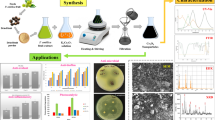Abstract
The study presented in this article investigated the influence of different Cr(III) and Cr(VI) compounds in the cultivation medium on the uptake and localization of chromium in the cell structure of the yeast Candida intermedia. The morphology of the yeast cell surface was observed by the scanning electron microscopy. Results demonstrated that the growth inhibitory concentration of Cr(III) in the cultivation medium induced changes in the yeast cell shape and affected the budding pattern, while inhibitory concentration of Cr(VI) did not cause any visible effects on morphological properties of the yeast cells. The amount of total accumulated chromium in yeast cells and the distribution of chromium between the yeast cell walls and spheroplasts were determined by atomic absorption spectroscopy. No significant differences were found neither in total chromium accumulation nor in the distribution of chromium in yeast cell walls and spheroplasts between the two of Cr(VI) compounds. Conversely, substantial differences between Cr(III) compounds were demonstrated in the total uptake as well as the localization of chromium in yeast cells.
Similar content being viewed by others
References
Anderson RA. 1998 Chromium, glucose intolerance and diabetes. J Am Coll Nutr 17, 548–555.
Arslan P, Beltrame M, Tomasi A. 1987 Intracellular chromium reduction. Biochim Biophys Acta 931, 10–15.
Batič M, Lenarčič D, Štupar J, Raspor P. 1996 Rapid method for screening the tolerance of yeasts to zinc(II) and chromium(III). J Rapid Methods Autom Microbiol 4, 265–278.
Belagyi J, Paš M, Raspor P, Pesti M, Pali T. 1999 Effect of hexavalent chromium on eukaryotic plasma membrane studied by EPR spectroscopy. Biochim Biophys Acta 1421, 175–182.
Beveridge TJ, Hughes MN, Lee H et al. 1997 Metal-microbe interactions: Contemporary approaches. Adv Microbiol Physiol 38, 177–244.
Bianchi V, Celotti L, Lanfranchi G et al. 1983 Genetic effects of chromium compounds. Mutat Res 117, 279–300.
Blackwell KJ, White JS, Tobin JM. 1999 A novel method for subcellular fractionation of Saccharomyces cereviasiae. Biotechnol Tech 13, 583–587.
Cotton FA, Wilkinson G. 1988 Advanced inorganic chemistry. Fifth edition. New York: John Wiley & Sons, Inc.; 680–697.
Curran BPG, Bugeja VC. 1996 Protoplast fusion in Saccharomyces cerevisiae. In: Evans IH, ed., Methods in molecular biology, vol. 53: Yeast protocols. Totowa: Humana Press Inc.; 45–49.
Davies DM, Holdsworth ES, Sherriff JL. 1985 The isolation of glucose tolerance factors from brewers yeast and their relationship to chromium. Biochem Med 33, 297–311.
Demirci A, Pometto AL. 2000 Enhanced organically bound chromium yeast production. J Agric Food Chem 48, 531–536.
Ding WJ, Qian QF, Hou XL, Feng WY, Chai ZF, Wangke. 2000 Determination of chromium combined with DNA, RNA and proteins in chromium-rich brewer's yeast by NAA. J Radioanal Chem 244, 259–262.
Gharieb MM, Gadd GM. 1998 Evidence for the involvement of vacuolar activity in metal(loid) tolerance: Vacuolar-lacking and-defective mutants of Saccharomyces cerevisiae display higher sensitivity to chromate, tellurite and selenite. BioMetals 11, 101–106.
Hansche R, Schauer P. 1995 Improved ultrastructural preservation of yeast cells for scanning electron microscopy. J Microsc 184, 81–87.
Harzdorf C, Lewalter J. 1997 Analytical methodology for biological monitoring. Regul Toxicol Pharmacol 26, 86–93.
HegÓczki J, Suhajda A, JanzsÓ B, Vereczkey G. 1997 Preparation of chromium enriched yeasts. Acta Aliment 26, 345–358.
Hughes MN, Poole RK. 1991 Metal speciation and microbial growth-the hard (and soft) facts. J Gen Microbiol 137, 725–734.
Krauter P, Martinelli R, Williams K, Martins S. 1996 Removal of Cr(VI) from ground water by Saccharomyces cerevisiae. Biodegradation 7, 277–286.
Lu YY, Yang JL. 1995 Long-term exposure to chromium(VI) oxide leads to defects in sulfate transport system in chinese hamster ovary cells. J Cell Biochem 57, 655–665.
Mertz W. 1998 A perspective on mineral standards. J Nutr 128, 375S–378S.
Muter O, Patmalnieks A, Rapoport A. 2001 Interrelations of the yeast Candida utilis and Cr(VI): Metal reduction and its distribution in the cell and medium. Process Biochem 36, 963–970.
Nies DH. 1999 Microbial heavy-metal resistance. Appl Microbiol Biotechnol 51, 730–750.
Paš, Prah S, Raspor P. 1999 Vpliv Cr(III) spojin na prezivelost kvasovk. Zbornik Biotehniske fakultete Univerze v Ljubljani, Kmetijstvo (1990) 73, 187–194.
Ramana VV, Sastry S. 1994 Chromium toxicity in Neurospora crassa. J Inorg Biochem 56, 87–95.
Rapoport AI, Muter OA. 1995 Biosorption of hexavalent chromium by yeasts. Process Biochem 30, 145–149.
Raspor P, Batič M, Jamnik P. 1999 Measurement of yeast viability/mortality in the presence of chromium(VI). Food Technol Biotechnol 37, 81–86.
Sakurai H, Tachikawa T, Shimomura S. 1978 Interaction of chromium with thiol-containing proteins, evidence for the formation of trivalent chromium. Anal Lett B11, 879–887.
Schmieman EA, Petersen JN, Yonge DR et al. 1997 Bacterial reduction of chromium. Appl Biochem Biotechnol 63-65, 855–863.
Shen H, Wang YT. 1993 Characterization of enzymatic reduction of hexavalent chromium by Escherichia coli ATCC 33456. Appl Environ Microbiol 59, 3771–3777.
Shi X, Chiu A, Chen CT, Halliwell B, Castranova V, Vallyathan V. 1999 Reduction of chromium(VI) and its relationship to carcinogenesis. J Toxicol Environ Health-Part B 2, 87–104.
Stearns DM. 2000 Is chromium a trace essential metal? BioFactors 11, 149–162.
Sumrall KH, Vincent JB. 1997 Is glucose tolerance factor an artifact produced by hydrolysis of low-molecular-weight chromium-binding substance? Polyhedron 16, 4171–4177.
Ščančar J, Milačič R. 2002 A novel approach for speciation of airborne chromium by convective-interaction media fast-monolithic chromatography with electrothermal atomic-absorption spectrometric detection. Analyst 127, 629–633.
Vincent JB. 2000 The biochemistry of chromium. J Nutr 130, 715–718.
Wang YT, Shen H. 1995 Bacterial reduction of hexavalent chromium. J Ind Microbiol 14, 159–163.
Author information
Authors and Affiliations
Corresponding author
Rights and permissions
About this article
Cite this article
Paš:, M., Milačič, R., Drašar, K. et al. Uptake of chromium(III) and chromium(VI) compounds in the yeast cell structure. Biometals 17, 25–33 (2004). https://doi.org/10.1023/A:1024437802914
Issue Date:
DOI: https://doi.org/10.1023/A:1024437802914




